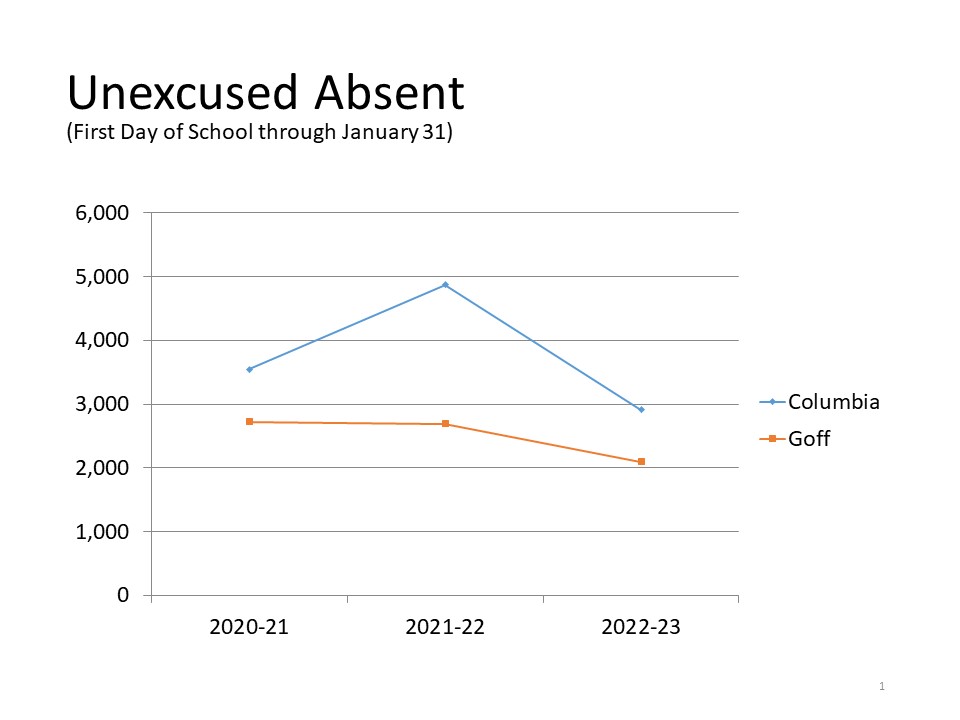 The following letter was sent to all PK-12 parents/guardians on Wednesday, March 8.
The following letter was sent to all PK-12 parents/guardians on Wednesday, March 8.
Dear Parent/Guardian,
At a recent Board of Education meeting, Columbia Principal Michael Harkin and Goff Interim Principal James McHugh shared student attendance data and discussed the ways in which teachers, staff and administrators are trying to improve attendance.
For most students, attending school every day is not an issue. But for some students, chronic absenteeism is affecting their learning and development.
What is Chronic Absenteeism?
The New York State Education Department classifies a student as being “chronically absent” when they miss 10 percent of school days, and it is different from truancy, which counts only unexcused absences. In the East Greenbush CSD, students are considered chronically absent when they miss 18 school days a year for any reason (10% of our 180 school day calendar). That works out to less than 2 days per month.
Over the course of a student’s high school career, missing 10 percent of school days would equate to missing almost an entire semester of school.
When students are consistently absent, they miss classroom instruction and fall behind. It becomes more and more difficult to catch up and do well on assignments as the class moves on to other material.
Attendance Interventions
Each of the schools in the East Greenbush CSD are working to improve attendance through a variety of strategies, including:
- Communicating with parents/guardians when a student is absent
- Establishing Attendance Notifications that are automatically sent to parents through ParentSquare when a student is marked “Unexcused Absent” or “Unexcused Tardy”
- Sending attendance letters home when students are consistently absent or late to school
- Hosting parent meetings at school to discuss attendance concerns
- Making home visits by administrators and school counselors
- Making home visits by the School Resource Officers
- Connecting families with service providers if there is a specific obstacle to getting the child to school
- Adding a new part-time Family Intervention Specialist at Goff to assist families with issues they are experiencing
Additionally, the district has an Attendance Committee that meets to discuss attendance issues and Columbia and Goff both have attendance-focused meetings every other week to monitor absence and tardy rates.
Attendance Data Shows Improvement, But More Room for Growth
Both Columbia and Goff have shown improvement in attendance data from last school year to this school year (September 1 through January 31). At Columbia, unexcused absences have decreased 40.2% and tardies have decreased 11.9%. At Goff, unexcused absences have decreased 22.0% and tardies have decreased 9.4%.
However, there is still a small percentage of students at each school who are classified as chronically absent or come to school late most days.
Students need to build the habit of getting to school every day and on time. This is an important skill that some students need to re-learn coming off the pandemic, especially as they prepare for college and careers.

This chart shows the total number of unexcused absences at Columbia and Goff from September through January for this school year and the previous two years.

This chart shows the total number of unexcused tardies at Columbia and Goff from September through January for this school year and the previous two years.
What Can Families Do?
Attending school regularly helps children feel better about school and themselves. Start building this habit in preschool so they learn right away that going to school on time, every day is important. Good attendance will help children do well in high school, college and in their careers.
What families can do:
- Avoid scheduling vacations when school is in session. They are considered unexcused absences. Vacations should be scheduled during school breaks including Holiday Recess, Winter Recess, Spring Recess and Summer.
- Build regular routines for bedtime and the morning.
- Lay out clothes and pack backpacks the night before.
- Take the bus to school. Busing is provided to all students and it’s the easiest way to be on time and avoid long parent dropoff lines.
- Talk about the importance of regular attendance and about how your child feels about school.
- Don’t permit missing school unless your child is truly sick. Use a thermometer to check for a fever. Remember that stomach aches and headaches may be signs of anxiety.
- If your child seems anxious about going to school, talk to teachers, school counselors, or other parents for advice on how to make them feel comfortable and excited about learning.
- Avoid medical appointments when school is in session.
- Keep a chart recording your child’s attendance at home. At the end of the week, talk with your child about what you see.
- Develop backup plans for getting to school if something comes up. Ask a family member, neighbor or another parent for help.
- Seek support from school staff or community groups to help with transportation, health problems, or no safe path to school.
Resources:
